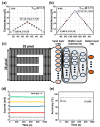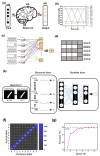Oxygen-Plasma-Treated Al/TaOX/Al Resistive Memory for Enhanced Synaptic Characteristics
- PMID: 39329600
- PMCID: PMC11430571
- DOI: 10.3390/biomimetics9090578
Oxygen-Plasma-Treated Al/TaOX/Al Resistive Memory for Enhanced Synaptic Characteristics
Abstract
In this study, we investigate the impact of O2 plasma treatment on the performance of Al/TaOX/Al-based resistive random-access memory (RRAM) devices, focusing on applications in neuromorphic systems. Comparative analysis using scanning electron microscopy and X-ray photoelectron spectroscopy confirmed the differences in chemical composition between O2-plasma-treated and untreated RRAM cells. Direct-current measurements showed that O2-plasma-treated RRAM cells exhibited significant improvements over untreated RRAM cells, including higher on/off ratios, improved uniformity and distribution, longer retention times, and enhanced durability. The conduction mechanism is investigated by current-voltage (I-V) curve fitting. In addition, paired-pulse facilitation (PPF) is observed using partial short-term memory. Furthermore, 3- and 4-bit weight tuning with auto-pulse-tuning algorithms was achieved to improve the controllability of the synapse weight for the neuromorphic system, maintaining retention times exceeding 103 s in the multiple states. Neuromorphic simulation with an MNIST dataset is conducted to evaluate the synaptic device.
Keywords: artificial synapse; neuromorphic system; plasma treatment; resistive switching.
Conflict of interest statement
The authors declare no conflicts of interest.
Figures







Similar articles
-
Improved Uniformity of TaOx-Based Resistive Switching Memory Device by Inserting Thin SiO2 Layer for Neuromorphic System.Materials (Basel). 2023 Sep 9;16(18):6136. doi: 10.3390/ma16186136. Materials (Basel). 2023. PMID: 37763413 Free PMC article.
-
Enhancement of Resistive and Synaptic Characteristics in Tantalum Oxide-Based RRAM by Nitrogen Doping.Nanomaterials (Basel). 2022 Sep 24;12(19):3334. doi: 10.3390/nano12193334. Nanomaterials (Basel). 2022. PMID: 36234461 Free PMC article.
-
Toward a Reliable Synaptic Simulation Using Al-Doped HfO2 RRAM.ACS Appl Mater Interfaces. 2020 Mar 4;12(9):10648-10656. doi: 10.1021/acsami.9b21530. Epub 2020 Feb 20. ACS Appl Mater Interfaces. 2020. PMID: 32043352
-
Resistive Random Access Memory (RRAM): an Overview of Materials, Switching Mechanism, Performance, Multilevel Cell (mlc) Storage, Modeling, and Applications.Nanoscale Res Lett. 2020 Apr 22;15(1):90. doi: 10.1186/s11671-020-03299-9. Nanoscale Res Lett. 2020. PMID: 32323059 Free PMC article. Review.
-
Resistive Switching Devices for Neuromorphic Computing: From Foundations to Chip Level Innovations.Nanomaterials (Basel). 2024 Mar 15;14(6):527. doi: 10.3390/nano14060527. Nanomaterials (Basel). 2024. PMID: 38535676 Free PMC article. Review.
References
-
- Ahn J.H., Choi H.S., Kim J.N., Park B.G., Kim S., Lee J., Kim Y. On-Chip Adaptive Matching Learning with Charge-Trap Synapse Device and ReLU Activation Circuit. Solid State Electron. 2021;186:108177. doi: 10.1016/j.sse.2021.108177. - DOI
-
- Yang R., Huang H.M., Guo X. Memristive Synapses and Neurons for Bioinspired Computing. Adv. Electron. Mater. 2019;5:1900287. doi: 10.1002/aelm.201900287. - DOI
-
- Kang D., Jang J.T., Park S., Ansari M.H.R., Bae J.H., Choi S.J., Kim D.M., Kim C., Cho S., Kim D.H. Threshold-Variation-Tolerant Coupling-Gate α-IGZO Synaptic Transistor for More Reliably Controllable Hardware Neuromorphic System. IEEE Access. 2021;9:59345–59352. doi: 10.1109/ACCESS.2021.3072688. - DOI
Grants and funding
LinkOut - more resources
Full Text Sources

